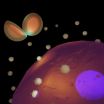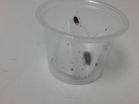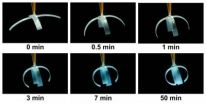(Press-News.org) Some grey seal mums adopt risky tactics when it comes to the future of their young, a strategy that can give their pup a real advantage, according to scientists.
Researchers from Durham University, UK, and the University of St Andrews, looking at grey seal colonies in Scotland, found that some seal mothers are flexible in the parenting style they adopt and 'gamble' on the outcome of their actions, whilst other play it safe and steady.
The study is the first to demonstrate how variation in personality traits in large marine mammals in the wild can persist, rather than a single, successful, personality type dominating the population.
The research shows that some seal mothers have a very fixed approach to looking after their pups, and tend to behave in a similar fashion whatever the local conditions on the breeding colony are; whether they are in a crowded and busy location, or in a less disturbed situation. These mums tend to achieve average success in terms of their pups' weight gain (crucial to the future survival of the pup), so that, by-and-large, they generally do well. These mums seem to have a 'play it safe' approach to life.
Some seal mothers have a very different approach. These mums are more flexible and try to adjust their mothering behaviour according to the local conditions. In potentially unpredictable situations, this can be risky; sometimes they get it right and their pups fare very well, but other times they might get it wrong and their pups do rather badly.
The findings, published in the journal PLoS One, show that individual animals can differ markedly in their ability to adjust their behaviour to their local environmental conditions and that large variations in behavioural strategies can persist within a species.
According to the researchers, the results for both extremes of personality show how different types can be maintained by selection. This retains behavioural diversity within a species, potentially making the species more resilient to environmental change.
The results are relevant to environment and conservation policies that use a one-size-fits-all approach, as these may need to be re-evaluated to take into account individual differences in animal personality, the researchers say.
Lead author, Dr Sean Twiss, School of Biological and Biomedical Sciences, Durham University, said: "Some mums have a very fixed way of caring for their pups, come what may, whilst others are more flexible.
"Seals that 'gamble' and try to fit their behaviour to their immediate surroundings can do very well, if they get it right! However, being flexible can be risky - a mum might 'mis-judge' the conditions and fail to match her behaviour to the prevailing conditions.
"In either resting or disturbed situations, seal mums behaved in very individual ways, some showing high levels of maternal attentiveness, others showing low levels. Some behaved the same when disturbed as they did at rest while other individuals changed their behaviour dramatically when disturbed."
These differences in mothers' behaviour, either fixed or flexible, can have profound effects on their pups. After about 2 weeks of being looked after by their mothers, all pups are left to fend for themselves, and have to teach themselves to feed. The fatter a mum leaves her pup, the more time the pup has to learn, and its chances of surviving are better.
The scientists observed seals on the Scottish island of North Rona during the breeding season over two years. The team observed seals in their natural habitat to analyse responses to unusual stimuli (disturbances) and to assess seal behaviour at rest.
Co-author Dr Paddy Pomeroy said: "What's really interesting about these short term tests is the way behavioural types map onto individual measures of reproductive success. If more flexible mothers are better and worse pup rearers, one of our next tasks will be to see how breeding successes and failures are apportioned over lifetimes, which can only be done in this type of study."
###
The research has been part-funded by NERC, The Living With Environmental Change partnership, and the Esmée Fairburn Foundation.
How they did it: The researchers ran 30-minute observations on 14 females to see how they behaved at rest. The team measured the attentiveness of the mothers towards their pups during these periods by recording the number of pup checks made (where the mother raises her head off the ground and moves it in the direction of her young to check their well-being).
Repeating these observations twice on each seal showed that mothers varied considerably, and consistently, in their behaviour, with some showing low levels of maternal attentiveness, whilst others checked their pups much more often.
The team then used a remote controlled vehicle (RCV) with a fitted video camera to test how seals reacted to mild disturbance, including approaches by the RCV and wolf calls played from the vehicle.
The seals varied in their responses to the RCV from almost completely ignoring its presence to pushing it with their muzzles. Again, mothers varied considerably in the number of pup checks they made during these disturbances.
The team also measured and weighed each seal mum and pup before and after each test and observation. Comparing these measurements for the behaviourally 'fixed' and 'flexible' seals, the team found an intriguing pattern: All mums with the 'fixed' approach had very average pup growth rates, while some of the 'flexible' mums did really well, with their pups growing at twice the rate of others, but the rest did rather poorly, with pup growth rates well below average.
The researchers can identify individual seals using their unique and varied patterns on their fur and this allows them to observe maternal behaviour over multiple years as seals generally return to the same site to breed.
Seals gamble with their pups' futures
2012-11-21
ELSE PRESS RELEASES FROM THIS DATE:
New American Chemical Society video series shines a light on transparent solar cells
2012-11-21
WASHINGTON, Nov. 20, 2012 — The American Chemical Society (ACS) today launched a new video series that highlights headline-making research from the society's suite of more than 40 peer-reviewed scientific journals. The first episode of Breakthrough Science focuses on research reported in one of those journals, ACS Nano. It involved development of new transparent solar cells, an advance toward giving windows in homes and other buildings the ability to generate electricity while still allowing people to see outside.
The video is available at http://pubs.acs.org/page/videos/breakthroughscience.html.
Breakthrough ...
Researchers find decline in availability and use of key treatment for depression
2012-11-21
Providence, RI - - Electroconvulsive therapy (ECT) is considered the most effective treatment option for patients with severe depression who cannot find symptom relief through antidepressant medications or psychotherapy. In a new study, researchers at Butler Hospital and Bradley Hospital in Rhode Island found a sharp decline in the availability and use of ECT in general hospitals across the U.S. The findings were published online in the journal Biological Psychiatry on October 10, 2012.
The researchers analyzed data from a nationally representative survey of US general ...
New method helps target Parkinson's disease
2012-11-21
Health professionals may soon have a new method of diagnosing Parkinson's disease, one that is noninvasive and inexpensive, and, in early testing, has proved to be effective more than 90 percent of the time.
In addition, this new method has the potential to track the progression of Parkinson's, as well as measure the effectiveness of treatments for the disorder, said Rahul Shrivastav, professor and chairperson of Michigan State University's Department of Communicative Sciences and Disorders and a member of the team developing the new method.
It involves monitoring a ...
Tiny probes shine brightly to reveal the location of targeted tissues
2012-11-21
Called BRIGHTs, the tiny probes described in the online issue of Advanced Materials on Nov. 15, bind to biomarkers of disease and, when swept by an infrared laser, light up to reveal their location.
Tiny as they are, the probes are exquisitely engineered objects: gold nanoparticles covered with molecules called Raman reporters, in turn covered by a thin shell of gold that spontaneously forms a dodecahedron.
The Raman reporters are molecules whose jiggling atoms respond to a probe laser by scattering light at characteristic wavelengths.
The shell and core create an ...
IUDs don't cause pelvic inflammatory disease in women
2012-11-21
The risk of developing pelvic inflammatory disease (PID) following insertion of an intrauterine device (IUD) is very low, whether or not women have been screened beforehand for gonorrhea and chlamydia, according to a joint study of nearly 60,000 women by researchers at the University of California, San Francisco (UCSF), and Kaiser Permanente Northern California Division of Research.
The study appears this week in the current online issue of Obstetrics & Gynecology, the official journal of the American College of Obstetricians and Gynecologists, also known as Green Journal.
The ...
New electrically-conductive polymer nanoparticles can generate heat to kill colorectal cancer cells
2012-11-21
WINSTON-SALEM, N.C., – Nov. 20, 2012 – Researchers at Wake Forest Baptist Medical Center have modified electrically-conductive polymers, commonly used in solar energy applications, to develop revolutionary polymer nanoparticles (PNs) for a medical application. When the nanoparticles are exposed to infrared light, they generate heat that can be used to kill colorectal cancer cells.
The study was directed by Assistant Professor of Plastic and Reconstructive Surgery, Nicole H. Levi-Polyachenko, Ph.D., and done in collaboration with colleagues at the Center for Nanotechnology ...
Natural fungus may provide effective bed bug control
2012-11-21
UNIVERSITY PARK, Pa. -- "And don't let the bed bugs bite" is no longer a harmless adage. In reality today, these bloodthirsty bugs infest thousands of homes. According to a team of Penn State entomologists, biopesticides -- naturally occurring microorganisms -- might provide an answer to this pest problem.
Bed bugs need blood meals for growth and development throughout their life cycle. Increased travel, widespread insecticide resistance and changes in management practices have caused a resurgence in those insects throughout North America and Europe. Compounding the problem ...
Scotch tape finds new use as grasping 'smart material'
2012-11-21
WEST LAFAYETTE, Ind. – Scotch tape, a versatile household staple and a mainstay of holiday gift-wrapping, may have a new scientific application as a shape-changing "smart material."
Researchers used a laser to form slender half-centimeter-long fingers out of the tape. When exposed to water, the four wispy fingers morph into a tiny robotic claw that captures water droplets.
The innovation could be used to collect water samples for environmental testing, said Babak Ziaie, a Purdue University professor of electrical and computer engineering and biomedical engineering.
The ...
Adenotonsillectomy may help resolve obstructive sleep apnea in children with Prader-Willi syndrome
2012-11-21
Children with Prader-Willi syndrome may receive relief from sleep disorders after undergoing an adenotonsillectomy, suggests a new study from Nationwide Children's Hospital published in the November print issue of the Archives of Otolaryngology-Head and Neck Surgery.
"Patients with Prader-Willi syndrome are at risk for sleep disordered breathing as growth hormone commonly used to treat their condition can cause the tonsils and adenoids to enlarge," said the study's lead author Kris Jatana, MD, FAAP, with Otolaryngology Head & Neck Surgery at Nationwide Children's.
"Growth ...
NASA spacecraft observe Nov. 20 solar eruption
2012-11-21
On Nov. 20, 2012, at 7:09 a.m. EST, the sun erupted with a coronal mass ejection or CME. Not to be confused with a solar flare, a CME is a solar phenomenon that can send solar particles into space and can reach Earth one to three days later. When Earth-directed, CMEs can affect electronic systems in satellites and on Earth.
Experimental NASA research models, based on observations from the Solar Terrestrial Relations Observatory (STEREO), show that the Nov. 20 CME left the sun at speeds of 450 miles per second, which is a slow to average speed for CMEs. CMEs can cause ...





